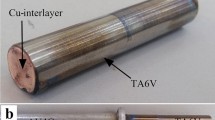Abstract
In situ TiB2 particle-reinforced Al matrix composite is a new kind of metal matrix composite (MMC). With in situ synthesis method, a better adhesion at interfaces is achieved and hence improves mechanical properties. Due to the presence of hard ceramic particles, the tool wear is seriously compared with traditional metal while cutting in situ TiB2/Al MMC. Many studies have been carried out on tool wear and wear mechanisms for cutting ex situ SiC/Al MMCs. However, few papers about the tool wear for cutting in situ particle-reinforced Al matrix composites have been published. In this paper, tool wear, tool life, and wear mechanisms for milling in situ TiB2/Al by using uncoated carbide tools were investigated. The results show that the tools were worn out at the initial tool wear stage, which indicated that the wear of tool was rapid. Among all the cutting parameters, milling speed has dominated influence on tool life, followed by feed rate and cutting depth. During milling in situ TiB2/Al MMC, the uncoated tools suffered from abrasive and adhesive wear, chipping and peeling wear, microcracks, and diffusion and oxidation wear.
Similar content being viewed by others
References
Omrani E, Moghadam AD, Menezes PL, Rohatgi PK (2015) Influences of graphite reinforcement on the tribological properties of self-lubricating aluminum matrix composites for green tribology, sustainability, and energy efficiency—a review. Int J Adv Manuf Technol. 1–22
Li XP, Seah WKH (2001) Tool wear acceleration in relation to workpiece reinforcement percentage in cutting of metal matrix composites. Wear 247(2):161–171
Ozben T, Kilickap E, Cakir O (2008) Investigation of mechanical and machinability properties of SiC particle reinforced Al-MMC. Int J Mater Prod Technol 198(1–3):220–225
Ciftci I, Turker M, Seker U (2004) Evaluation of tool wear when machining SiCp-reinforced Al-2014 alloy matrix composites. Mater Des 25(3):251–255
El-Gallab M, Sklad M (1998) Machining of Al/SiC particulate metal-matrix composites—part I: tool performance. Int J Mater Prod Technol 83(1–3):151–158
Ge YF, Xu JH, Yang H (2010) Diamond tools wear and their applicability when ultra-precision turning of SiCp/2009Al matrix composite. Wear 269(11–12):699–708
Andrewes CJE, Feng HY, Lau WM (2000) Machining of an aluminum/SiC composite using diamond inserts. Int J Mater Prod Technol 102(1–3):25–29
Manna A, Bhattacharayya B (2005) Influence of machining parameters on the machinability of particulate reinforced Al/SiC-MMC. Int J Adv Manuf Technol 25(9–10):850–856
Bhushan PK, Kumar S, Das S (2010) Effect of machining parameters on surface roughness and tool wear for 7075 Al alloy SiC composite. Int J Adv Manuf Technol 50(5–8):459–469
Suresh S, Shenbag N, Moorthi V (2012) Aluminium-titanium diboride (Al-TiB2) metal matrix composites: challenges and opportunities. Procedia Engineering 38:89–97
Ramesh CS, Ahamed A, Channabasappa BH, Keshavamurthy R (2010) Development of Al 6063-TiB2 in situ composites. Mater Des 31(4):2230–2236
Anandakrishnan V, Mahamani A (2011) Investigations of flank wear, cutting force, and surface roughness in the machining of Al-6061–TiB2 in situ metal matrix composites produced by flux-assisted synthesis. Int J Adv Manuf Technol 55(1–4):65–73
Wang ML, Chen Z, Chen D, Wu Y, Li XF, Ma NH, Wang HW (2014) The constitutive model and processing map for in-situ 5 wt% TiB2 reinforced 7050 Al alloy matrix composite. Key Eng Mater 575–576:11–19
Bushlya V, Zhou JM, Avdovic P, Stahl JE (2013) Wear mechanisms of silicon carbide-whisker-reinforced alumina (Al2O3-SiCw) cutting tools when high-speed machining aged Alloy 718. Int J Adv Manuf Technol 68(5–8):1083–1093
Trent EM, Wright PK (2000) Metal cutting. Butterworth-Heinemann, New York
Chen R (1992) Principle of metal cutting. China Machine, Beijing
Davim JP, Baptista AM (2000) Relationship between cutting force and PCD cutting tool wear in machining silicon carbide reinforced aluminium. Int J Mater Prod Technol 103(3):417–423
Lin J, Bhattacharyya D, Lane C (1995) Machinability of a silicon carbide reinforced aluminium metal matrix composite. Wear 181:883–888
Sahin Y (2005) The effects of various multilayer ceramic coatings on the wear of carbide cutting tools when machining metal matrix composites. Surf Coat Technol 199(1):112–117
Dabade UA, Joshi SS (2009) Analysis of chip formation mechanism in machining of Al/SiCp metal matrix composites. Int J Mater Prod Technol 209(10):4704–4710
Ernst H (1938) Physics of metal cutting. Cincinnati Milling Machine Company
Author information
Authors and Affiliations
Corresponding author
Rights and permissions
About this article
Cite this article
Xiong, Y., Wang, W., Jiang, R. et al. Tool wear mechanisms for milling in situ TiB2 particle-reinforced Al matrix composites. Int J Adv Manuf Technol 86, 3517–3526 (2016). https://doi.org/10.1007/s00170-016-8449-z
Received:
Accepted:
Published:
Issue Date:
DOI: https://doi.org/10.1007/s00170-016-8449-z




